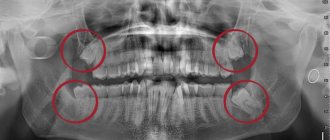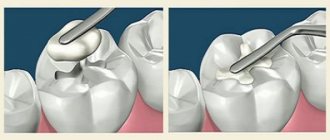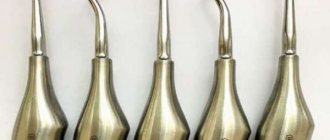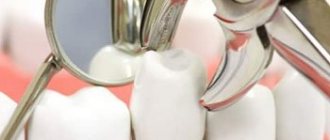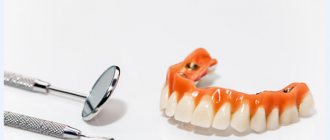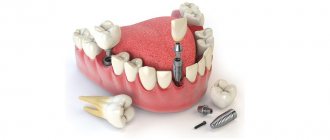Extracting the root of a badly damaged or broken tooth is one of the most time-consuming, painstaking and unpleasant dental procedures, requiring all the skill and knowledge of the surgeon. This is due to the fact that the roots of some teeth have a very complex anatomical structure, and their fragments can remain inside the gums. The dental surgeons at Dr. Granov’s clinic take their work very seriously and have extensive experience in successfully performing such operations. The root of a tooth may remain in the gum as a result of unsuccessful tooth extraction or injury. Usually in such cases, our patients are bothered by the sensation of a foreign object in the gum or pain in neighboring teeth. In addition, root fragments are clearly visible on an x-ray.
How a tooth root is removed in our clinic
A mandatory step in this procedure is the administration of local anesthesia. Typically, the pain relief lasts for several hours, and you will not experience any discomfort during the removal. After removal, a course of antibiotics is usually prescribed. As for the root removal process itself, the surgeon’s actions and the choice of instrument largely depend on the following circumstances:
- how deep is the root of the tooth;
- where the tooth is located: on the upper or lower jaw;
- are there pathological changes in the tissues around it, etc.
Reviews
In most cases, tooth extraction is performed using forceps. However, with a badly damaged crown, when there is no way to reliably grasp it with forceps, dental surgeons resort to the help of an elevator.
In essence, due to anesthesia, the patient does not feel much difference when removing a tooth with forceps or a lift. Not counting, perhaps, the duration of the operation (the tooth is removed faster with forceps).
If you had a tooth removed using an elevator, tell us about your feelings during and after the operation. The comment form is at the bottom of this page.
If you find an error, please select a piece of text and press Ctrl+Enter.
Tags dentist tools tooth extraction
Did you like the article? stay tuned
No comments yet
Removing a tooth root using forceps
First, the doctor separates the periodontal tissue from the root so that the exposed part of the root can be easily grabbed with forceps. If this is difficult to do, the doctor separates the periosteum and the edge of the mucosa from the socket. It is much more difficult to remove upper teeth than lower teeth, so bayonet-shaped and S-shaped forceps are used for this. The doctor places the instrument as tightly as possible and makes rotational movements with it. If the tissues surrounding the tooth are affected by an inflammatory process, then the problematic root can be extracted quite quickly. The most difficult teeth in this regard are the canines and lower molars, since they have large alveolar processes.
Tooth root removal using an elevator
In cases where the tooth root is located very deep and is difficult to reach with forceps, an elevator is used to remove it. The doctor inserts this instrument into the narrow gap between the edge of the hole and the root, and then rotates it while simultaneously pressing lightly. With these movements, the periodontal ligaments holding the root are torn. Using the elevator as a kind of lever, the doctor seems to push the root out of the hole. Even if it does not come out of the gum completely, the exposed part is enough to pull it out with forceps.
Important nuances when working with the tool
The first thing you need to do when working with an elevator is to make sure that the choice of tool is justified and that the tooth cannot be removed with forceps.
It is necessary to carefully examine the crown to determine its ability to withstand the pressure of the forceps without destruction. If the remains of the crown interfere with removing the tooth with an elevator, it must be bitten off.
The disadvantage of direct elevators is that the cheek is too massive , preventing its deep penetration into the periodontal fissure.
To compensate for this drawback, before inserting the elevator, it is recommended to use a fissure bur to form a gap between the alveolar wall and the root.
As another measure to combat this deficiency, grinding of the cheek can be used to make it thinner and sharper.
The types of elevators are not limited to straight, corner and bayonet-shaped. There are many others that may be optimal in certain clinical situations.
To remove small root fragments, for example, it is convenient to use an elevator with thin cheeks located either on one side of the intermediate part or on two.
In general, the shape of dental lifts changes over time. Some become rarely used and are replaced by others.
In particular, an elevator known as a “goat leg”, in which the working part is curved along a plane, was previously widely used.
“If only I had a goat’s leg,” the hero of A. Chekhov’s story “Surgery” mutters sadly after an unsuccessful attempt to remove a tooth.
Modern Easy Graft material for simplified and high-quality dental treatment.
In this publication, we will consider the reasons for the development of exostosis after tooth extraction.
Here https://zubovv.ru/hirurgiya/udalenie-zubov/posle-ostalsya-oskolok.html find out whether a splinter may remain after tooth extraction.
The nuances of wisdom tooth root removal
In most cases, wisdom teeth are formed incorrectly and grow at an angle, so their roots are often located perpendicular to the roots of neighboring teeth and have a complex shape. Serious problems can arise even before the “eights” fully erupt. Removal of the roots of wisdom teeth occurs under regular x-ray control, especially if their coronal part is destroyed. Only a very experienced doctor can correctly extract the roots, otherwise irreparable harm can be caused to the roots of healthy neighboring teeth.
General overview
The main types of dental surgical instruments include scalpels, curettes, scissors, forceps, elevators, clamps and tweezers.
A dental elevator (or lift - from the Latin Elevator - lifting) is the second most popular surgical instrument after forceps.
It is an oblong (150-160 mm long, 10-20 mm thick) structure, consisting of a working and intermediate part, and a handle. The working part is called “cheeks”.
Elevators are used to remove roots and their fragments, as well as dystopic or damaged teeth that cannot be removed with the main extraction tool - forceps.
During the removal process, the elevator performs the following manipulations:
- The tooth or root being removed is loosened (luxurized - from the Latin Luxatio - displacement).
- They dislocate it, that is, they break the connection of the tooth or root with the periodontal ligament.
- It is completely turned out of the hole or, as a last resort, transferred to a position in which it becomes possible to grasp it with forceps.
Elevators must meet the following requirements:
- Be strong, able to withstand the force applied by the surgeon without breaking or bending. And at the same time light, not causing fatigue in the hand.
- Ergonomic, easy to hold and well balanced.
- Have a non-slip handle.
- Be minimally traumatic to the alveolar bone and soft tissues.
An additional advantage of elevators is color coding, which makes tool selection easier.
Depending on their configuration, lifts have different shapes and technological capabilities.
Their main differences include the following:
- The position of the cheek relative to the intermediate part. The working part can be located on the same line with the intermediate one, or have an inclination relative to it.
- Cheek shape. Characterized by a large number of designs.
Most often, the cheeks have the form of a symmetrical or asymmetrical groove with pointed edges of a rectangular, round or spear-shaped configuration. The width of the cheeks is usually from 3 to 5 mm, but it can be smaller.The pointed part may have serrations that keep the tool from sliding off the fragment being removed.
- The shape of the handle and its position relative to the intermediate part.
The handle can be a continuation of the intermediate part and be in line with it, or located perpendicular to it or at some arbitrary angle.
Elevators are made of alloyed stainless steel, the requirements for which are regulated by GOST 30208-94 and R 50328.1-92.
Examples of steel grades for lifts include 30X13, 20X13, 45X14.
Is it necessary to remove tooth roots?
The issue of tooth root removal can only be decided by your attending dentist based on the examination and the X-ray obtained. If it is not a source of infection and the tissues surrounding it are healthy, then the root can be used in the future as a support for an artificial crown, having previously “extended” it using a stump tab. Tooth root extraction is highly recommended in the following situations:
- a cyst has formed on the root of the tooth;
- the tooth was severely damaged by caries;
- root fracture;
- one of the walls of the tooth has broken off, and the chip goes deep into the gums;
- There is severe tooth mobility caused by periodontal diseases.
Possible complications
Any surgical operation, even something as seemingly simple as tooth extraction, can result in complications.
If we talk about the negative consequences of tooth extraction, which are determined by the type of instrument used (in our case, an elevator), then these include the following:
- Injury to the cheek of soft tissues. This is not such a rare case, since the working part of the instrument is sharp, and significant force is applied to it, which is necessary to loosen and extract the tooth fragment.
- Bleeding caused by damage to a large vessel.
- Infection of the hole with a poorly sterilized elevator. Sterilization of surgical instruments should be treated with great care.
When it comes to dental instruments, there is a specific sterilization protocol, the strict implementation of which helps to avoid infection of the patient. - Luxation of an adjacent tooth, used as a support when applying force to the elevator.
Since the instrument is a simple double-armed lever, it requires a support, which is used as the tooth adjacent to the tooth being removed.If excessive force is applied to the elevator, the abutment tooth may dislocate.
- Damage to the follicle of a permanent tooth. Sometimes it happens when removing the “milk jug”, under which there is an embryo of a permanent tooth.
The risk of damage increases due to the fact that the dental septum in the mixed dentition has not yet gained sufficient hardness. - The tip of the elevator breaks off and gets stuck in the alveolar socket.
- Fracture of the alveolar ridge. The most rare, but sometimes still occurring complication caused by excessive application of force to the instrument.
Most of the above complications can be attributed to the conscience of the doctor who allowed them.
Although there may be objective reasons, which include the individual characteristics of the dental apparatus of a particular patient.
The video provides additional information on the topic of the article.
The most frequently asked questions from our patients
What happens if the tooth root is left in the gum?
If the root of the tooth is left as is, it becomes a source of infection, and after some time serious complications may develop, for example:
- inflammation of the tissues surrounding the tooth, including bone;
- penetration of infection into the wound surface;
- periodontal disease.
What is a root canal and can it be treated rather than removed?
The root (or dental) canal is an anatomical space inside the root of a tooth filled with pulp. Cleaning and treatment of dental canals is a mandatory stage of dental fillings and prosthetics. In our clinic, for this purpose, we use self-adapting files of the SAF system, which carefully clean the canals from dead and diseased tissue, pus, and accumulations of bacteria, without injuring healthy areas of the tooth. Thanks to their hollow structure, the doctor can simultaneously treat the root canal with disinfectants and anti-inflammatory drugs. Root canals are preserved only if the tissues surrounding the tooth are not affected by pathological processes, and in the future the root can be used for prosthetics.
If the tooth can still be restored, root canal treatment (roots) of the tooth is performed. It can be successfully completed in our Moscow clinic.
